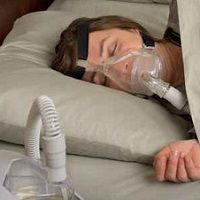Article
Investigators Reconsider ASV Device Risks for CSA-HFrEF Patients
Author(s):
Investigators found that treating for CSA in the patient population significantly decreases mortality risk—despite previous clinical warnings.

A pair of new analyses bring a differing perspective to the debate surrounding adaptive servo ventilation (ASV) device therapy in patients with heart failure with reduced ejection fraction (HFrEF) and central sleep apnea (CSA).
The data, presented at the 2018 CHEST Annual Meeting in San Antonio, TX, bucked concerns that ASV therapy is associated with greater mortality in patients with both conditions. Ajay Saraf, a research associate with the Ohio State University Sleep Heart Program, shared findings showing the therapy increases mortality risk no more than no therapy at all.
ASV currently bears a US Food and Drug Administration (FDA) Black Box label warning due to its association with increased mortality risk from heart failure in patients treated for HFrEF and CSA. Saraf noted this is particularly due to the results of studies such as Adaptive Servo-Ventilation for Central Sleep Apnea in Systolic Heart Failure (SERVE-HF) trial, in which 1325 patients chronic heart failure with a reduced ejection fraction randomized to either management therapy, or therapy plus ASV.
Investigators had concluded ASV had no significant effect on the primary endpoint in patients, but increased all-cause and cardiovascular mortality.
In assessing the sole treatment of CSA with SRV in patients with both the sleeping disorder and HFrEF, Saraf and his team pulled from a pre-established population of patients at the university’s Sleep Heart Program. They compared mortality between ASV-treated HFrEF-CSA patients, and patients who previously did not accept positive airway pressure (PAP) therapy. They assessed medical records to establish treatment status, and pulled mortality data from the OSU-Information Warehouse.
Treatment status was defined as selecting device therapy in the first year following patient diagnosis, with untreated patients verified by investigators when they had not received any treatment for at least 2 years post-diagnosis. Patients who selected other PAP or oxygen-based therapy we excluded from analysis.
Investigators identified 268 CSA-HFrEF patients; just 86 (32%) had opted into ASV therapy. Mean patient age was similar across patients treated with ASV (60.4) or untreated (61.2), as was the rate of males (81 [94%] vs 160 [83%]) and mean patient body mass index (BMI) (30.1 vs 28.6).
Investigators used a Cox proportional Hazards model to calculate mortality hazard ratio for ASV therapy versus non-treatment, with adjustments set for age, sex, BMI, and variables regarding patient health. They found an adjusted mortality that was significantly lower in ASV patients compared to non-therapy patients (HR= .44; 95% CI: .25 - .77; P = .004).
In the second propensity score-matching analysis, Saraf and his team paired ASV recipients with an untreated patient, based on demographic covariates. In attempting to match at an optimal distance of < .1, they were able to pair 74 patients from each treatment arm with one another. Using the hazards model to account for the paired data, investigators found a statistically significant and even lower mortality risk in ASV compared to non-treatment (HR= .28; 95% CI: .16 - .50; P < .001).
In assessing over 4 years, mortality function was significantly lower for ASV at each 12-month interval (5% vs 20% at 12 months; 17% vs 38% at 24 months; 27% vs 59% at 36 months; 31% vs 77% at 48 months).
Investigators concluded that ASV is significantly associated with low mortality in treated patients with HFrEF-CSA, as well as improved outcomes in patients. That said, Saraf noted the entire patient population had higher implantation of implantable cardioverter defibrillators, and patients were on newer generations of ASV devices, fitted with adjustable end-expiratory pressure.
“Further studies are needed to determine the mechanism of harm associated with ASV treatment in HFrEF patients,” investigators concluded.
The study, "Treatment of CSA Is Associated with Decreased Mortality in Patients with HFrEF," was presented at CHEST 2018 on Sunday.
Click here to sign up for more MD Magazine content and updates.
Related Coverage >>>
Secondhand Factors in Asthma Not Significant in Overall Disease Improvement
Gender Differences Discovered in Emerging OSA Phenotype
Therapy Disruption by Medicare Coverage Could Harm Asthma Control




